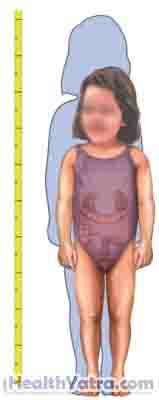परिभाषा
The term short stature describes height that is in the third percentile as compared to that of the average height for a person’s age, sex, and racial group.
Short stature is generally broken down into three subgroups: familial short stature, constitutional delay and development, and that caused by chronic disease. Familial short stature usually does not require doctor’s care. However, if short stature is related to growth hormone deficiency, the child will need to be treated before reaching puberty to achieve his/her maximum height potential.

का कारण बनता है
Several factors contribute to short stature, including:
- Genetic factors (eg, skeletal dysplasias, Turner syndrome, Downs syndrome, Silver Russell syndrome)
- Endocrine disorders (eg, hypothyroidism, growth hormone deficiency)
- Delayed puberty (causes temporary short stature, but normal height is eventually achieved)
- Early puberty
- Malnourishment (on a global scale, this is the most common cause of growth failure and is generally associated with poverty)
- Chronic diseases:
- Congenital heart disease
- Kidney diseases
- दमा
- दरांती कोशिका अरक्तता
- Gastrointestinal disorders (eg, inflammatory bowel disease)
- Lung conditions ( cystic fibrosis, severe asthma, chronic obstructive pulmonary disease)
जोखिम कारक
A risk factor is something that increases your chance of getting a disease or condition. Some risk factors for short stature are:
- Having family members with short stature
- अल्प खुराक
- Certain diseases and drugs taken by a pregnant woman will increase risk to the newborn child
Contact your child’s pediatrician if you notice a significant decrease in his or her growth rate compared to siblings or friends of similar age, or if your child has stopped growing.
लक्षण
Symptoms vary depending on the type of condition. Children with familial short stature do not have any disease-related symptoms and will typically reach a height similar to that of their parents.
Children who have delayed puberty, “late bloomersâ€, typically have a close relative with this history and will eventually catch up to their peers in height.
Some symptoms may indicate a medical condition causing short stature. These may include:
- Stopped or dramatically slowed growth (below the third percentile as determined by your doctor)
- Weight loss or gain (more than five pounds in a month)
- खराब पोषण
- भूख में कमी
- Chronic abdominal pain and diarrhea
- Persistent fever
- Chronic headaches and/or vomiting
- Delayed puberty (no spotting by age 15 for a girl or no enlargement of the testes by age 14-15 for a boy)
There are other complications related to short stature, such as obstructed sleep apnea.
निदान
Your childs pediatrician will ask about symptoms and medical history. He or she will perform a physical exam to determine height, weight, body proportion (sitting height, trunk-limb proportion), and an exam of craniofacial (skull and face) features.
परीक्षण में शामिल हो सकते हैं:
- Bone age: an x-ray to determine the chronological age of your child’s bones
- Blood tests:
- To check for hypothyroidism–thyroxine (T4) and thyroid-stimulating hormone (TSH)
- To check growth hormone levels–insulin-like growth factor-1 (IGF-1) and IGF-binding protein-3 (IGFBP-3)
- A complete blood count to check for blood diseases
- A genetic exam to detect chromosomal abnormalities and to exclude Turner syndrome (a common cause of short stature in girls)
- मूत्र-विश्लेषण
उपचार
Treatment depends on the cause of short stature. Children with familial short stature do not require treatment.
दवाएं
- Thyroid hormone replacement therapy may be used in children with hypothyroidism
- Growth hormone replacement (Genotropin, Humatrope) may be used in children with growth hormone deficiency, Prader Willi syndrome, and Turner syndrome
सर्जरी
Surgery may be necessary if the cause of growth hormone deficiency is a मस्तिष्क का ट्यूमर, a rare possibility.
रोकथाम
Short stature cannot be prevented in children who have a familial short stature or those who have a chronic disease. However, in some cases, you can minimize your child’s risk of developing short stature by making sure the child eats a nutritious diet.
Parents can minimize the risk of short stature in their children by eating a nutritious diet during pregnancy and avoiding nonprescription drugs and unsafe sex.
Complications to the condition can be prevented and/or treated if identified early with prenatal testing.
